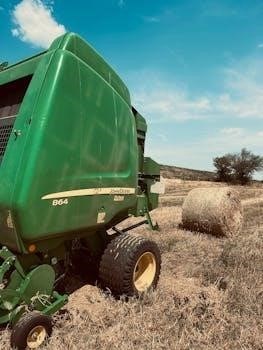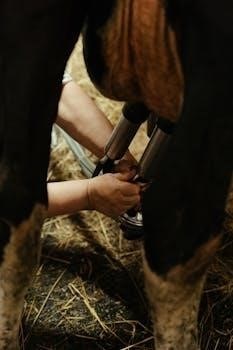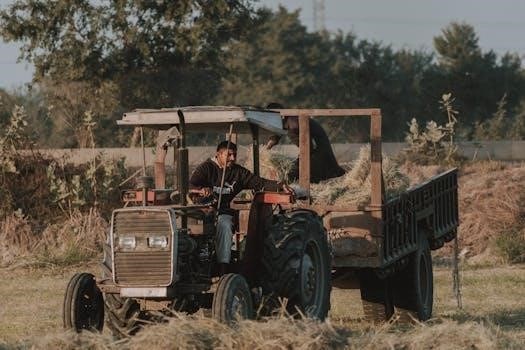
What is a Manual Hay Baler?
A manual hay baler is a device designed to compress loose hay into manageable bales by hand․ This type of baler is often used by small-scale farmers and homesteaders, offering a simple method for hay baling․ It does not require tractors or powered equipment․
Definition and Purpose
A manual hay baler is a hand-operated machine specifically engineered to compress loose hay into compact, easily handled bales․ Its primary purpose is to facilitate the storage and transport of hay, making it more convenient for use as animal feed or for sale․ This tool allows for efficient baling without the need for powered machinery, thereby simplifying the process for those without access to tractors․ It’s a cost-effective solution for small-scale operations, enabling hay production with minimal equipment․

Who Uses Manual Hay Balers?
Manual hay balers are commonly used by small-scale farmers and homesteaders․ They are ideal for those who need to bale hay without using tractors or other powered equipment․ These users find them practical and cost-effective․
Small-Scale Farmers and Homesteaders
Small-scale farmers and homesteaders find manual hay balers particularly useful due to their simplicity and affordability․ These users often have limited access to large machinery and prefer a hands-on approach to farm work․ Manual balers allow them to efficiently manage hay production without relying on expensive, powered equipment․ The convenience and practicality of these balers make them a valuable tool for those with smaller land holdings and limited resources, enabling them to bale hay for their livestock․
Advantages of Using a Manual Hay Baler
Manual hay balers offer cost-effectiveness, simplicity, and ease of use․ They eliminate the need for tractors or powered equipment, making them ideal for small-scale farming and homesteading, providing an accessible hay-baling solution․
Cost-Effectiveness
Manual hay balers are significantly more cost-effective compared to their powered counterparts․ The initial investment is much lower, as there is no need for expensive machinery like tractors․ Operating costs are also reduced because manual balers do not require fuel or electricity․ This makes them a great choice for small-scale farmers with limited resources, allowing them to bale hay without incurring high operational expenses or needing a big initial capital investment․ The simplicity of their design also reduces maintenance costs․
Simplicity and Ease of Use
Manual hay balers are designed with simplicity in mind, making them user-friendly․ Their straightforward operation means they do not require extensive training or technical expertise․ The absence of complex machinery or electronic components makes them easy to understand and operate; This simplicity allows individuals with limited experience to quickly learn how to bale hay effectively․ The design typically involves a simple loading box and a compression mechanism, ensuring a hassle-free baling process, and a simple learning curve․
No Need for Tractors or Powered Equipment
A significant advantage of manual hay balers is their independence from tractors or other powered equipment․ This feature makes them ideal for situations where such machinery is unavailable, impractical, or too expensive․ They offer a solution for farmers who prefer to use manual methods or lack the resources for larger, mechanized options․ This self-reliance reduces operating costs and eliminates the need for fuel, electricity, or additional maintenance associated with powered equipment, offering a more sustainable option for hay baling․
How to Use a Manual Hay Baler
Using a manual hay baler involves setting up the baler with twine and then loading the hay into the baling box․ The compression lever is then used to create bales effectively․
Step-by-Step Baling Process
The manual baling process begins by placing a loop of twine over the eye hook, running it inside the loading box, and under the gap of the floor․ Load the hay into the baler, using the compression lever to compact it․ Add more hay, repeating the compression process until the bale is the desired size․ Once the bale is complete, secure the twine and remove the finished bale․
Setting Up the Baler with Twine
Setting up the manual hay baler with twine is a crucial step for successful baling․ Begin by placing a loop of polypropylene twine over the eye hook located at the back of the baler․ Then, guide the twine down the inside of the loading box․ Run the twine under the gap between the eye hooks and the wooden strip on the baler’s floor․ Ensure the twine is positioned correctly, ready to secure the compressed hay․

Construction of a Manual Hay Baler
Manual hay balers are often built using wood, with some metal components for strength․ DIY plans often incorporate recycled materials, like pallets․ Adaptations can be made to suit specific needs and available resources․
Materials and Tools Required
Constructing a manual hay baler typically involves using wood such as 3×2 and 4×2 timber, along with plywood for the bin lining․ You’ll need screws, nuts, and bolts for assembly․ Recycled materials like pallets can also be utilized․ Essential tools include a saw for cutting wood, a drill for creating holes, and wrenches or spanners for tightening fasteners․ Measuring tools and safety equipment are also necessary for the build․
DIY Plans and Adaptations
Many individuals create their own manual hay balers using available plans, often adapting them to suit their specific needs and available resources․ Plans from sources like Caring for Gods Acre provide a starting point, with builders making adjustments to the dimensions and materials․ Adaptations might include using different types of wood, modifying the size of the baling chamber, or incorporating unique features for increased efficiency․ This allows for customization based on individual requirements․

Types of Materials Baled
Manual hay balers are versatile, capable of baling not only hay but also materials like pine straw, alfalfa, and other forage․ This makes them useful for different agricultural and landscaping needs․
Hay, Pine Straw, and Other Forage
Manual hay balers are not limited to just baling hay; they can also handle various other materials․ Commonly, they are used to create bales of pine straw, which is useful for landscaping and mulching․ Additionally, these balers can process different types of forage, such as alfalfa and other grasses, making them a versatile tool for small farms and homesteads․ The ability to handle different materials enhances their overall utility, allowing for efficient management of diverse agricultural byproducts․
Maintenance of a Manual Hay Baler
Maintaining a manual hay baler involves calibrating it for different crops and moisture levels․ Regular checks of tension and alignment are necessary for smooth operation․ Proper maintenance is key․
Calibration and Tension Adjustments
Proper calibration of a manual hay baler is essential for optimal performance, and this involves adjusting the machine based on the type of crop and its moisture content․ Regularly check the tension of belts, if applicable, and ensure correct alignment for smooth operation․ Most balers feature vertical threaded rods to adjust resistance, allowing for tighter packing of hay by narrowing the chamber’s exit․ This ensures that the hay bales are compact and well-formed, thus increasing the effectiveness of the baling process․
Where to Find Manual Hay Balers
Manual hay balers can be found through various purchasing options, often from specialized agricultural suppliers or online retailers․ Availability may vary depending on the region and the specific model sought․
Purchasing Options and Availability
When looking to purchase a manual hay baler, several avenues are available․ You can explore online marketplaces that specialize in agricultural equipment, or check with local farm supply stores․ Some manufacturers may also offer direct sales․ Availability can fluctuate depending on your location and the time of year, so it’s advisable to check multiple sources․ Consider also looking for used models, which can be a more cost-effective option․ Always verify the condition and reliability of the seller before making a purchase․

Efficiency of Manual Hay Balers
Manual hay balers are significantly slower than powered balers, requiring more time and physical effort․ However, they are suitable for small-scale operations, where speed is not the primary concern․
Comparison to Powered Balers
Powered hay balers, typically tractor-driven, offer significantly higher baling speeds and can handle larger volumes of hay compared to manual options․ However, they require substantial investment in equipment and fuel․ Manual balers, while slower and more labor-intensive, are more cost-effective, particularly for small farms or homesteads that don’t need large-scale hay production․ The choice between manual and powered balers depends greatly on the scale of operation and available resources․ Manual balers are ideal for smaller operations while powered balers are better suited for larger farms․